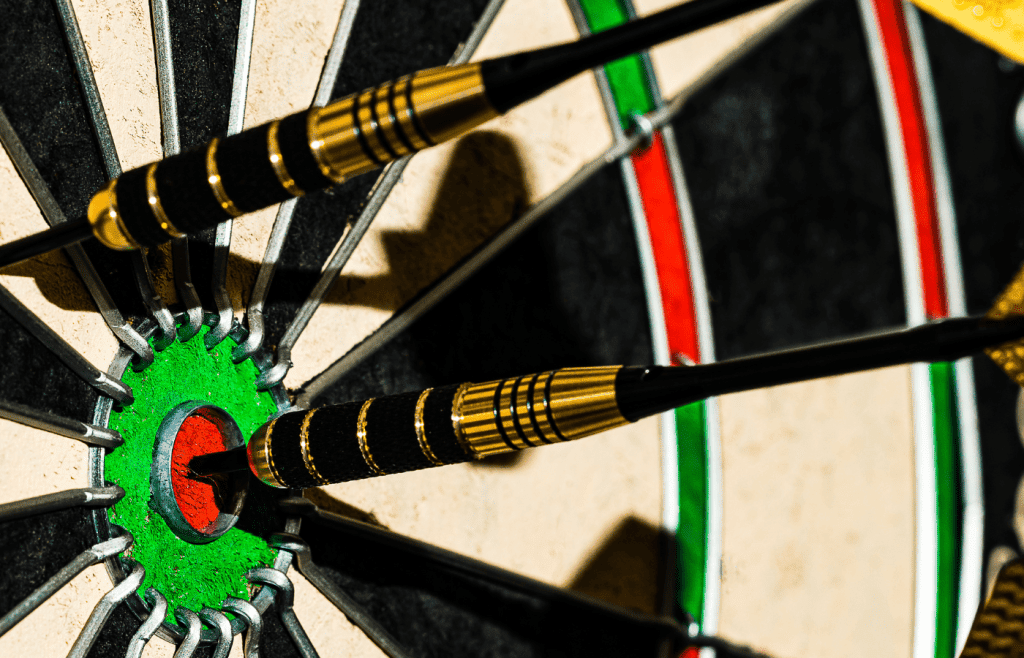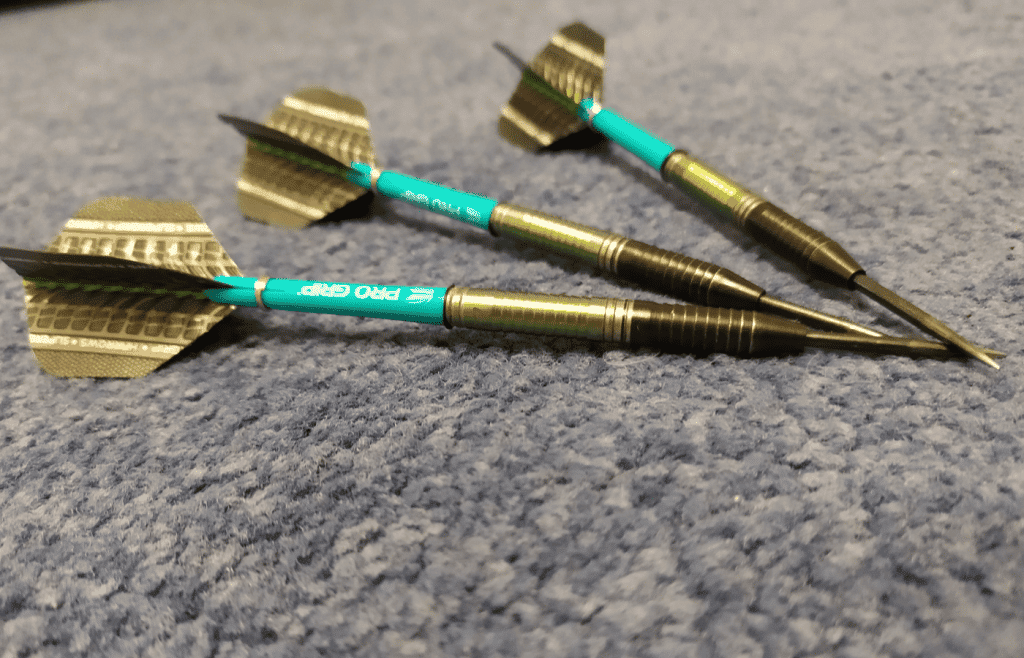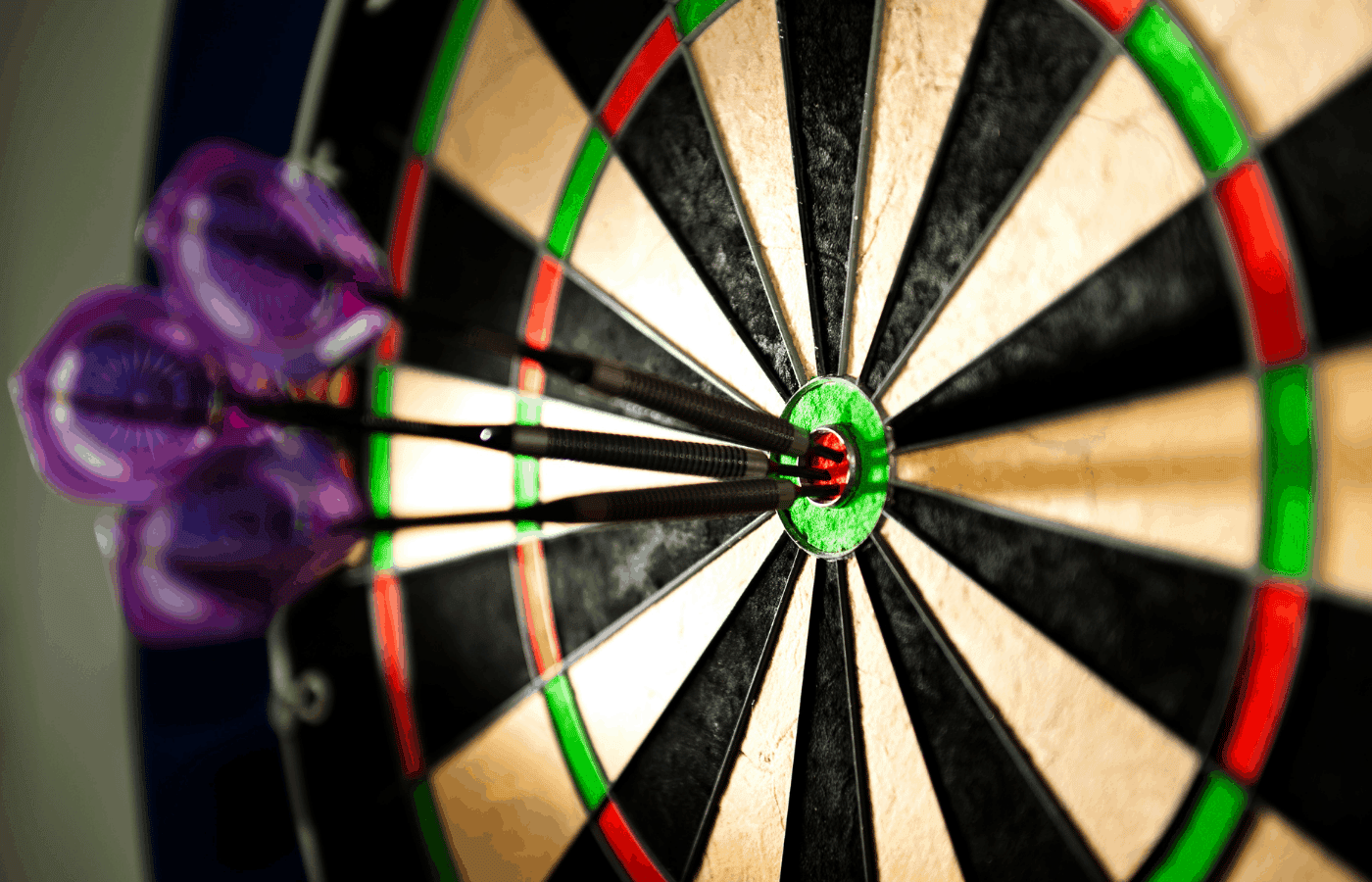There is no superior dart shaft size. The ideal shaft length entirely depends on the player and their specific technique. How the player grips the dart when throwing will determine the best length of shaft for them.
If you tend to hold the dart closer to the front, a shorter shaft is best. If you prefer holding your darts towards the back, you may have more luck with longer shafts.
The reasoning behind this is that shorter shafts push the dart’s center of gravity towards the front. While longer shafts will send it further back. If this is too technical for you, we get it! That’s why we’ve put together a dart shaft guide to help you choose the right shaft so you can throw like a champion every time.
What Is the Shaft of a Dart?

The shaft is a very important feature when it comes to darts. Why? Primarily because it dictates where the dart’s center of gravity sits which determines how the dart will move through the air when you throw it and ultimately, where it will land.
The shaft is the long part between the flight and the barrel, the two other features you can read more on here.
If you’re aiming to sound like a seasoned dart player, you can call it a stem instead of a shaft.
How Do You Pick a Dart Shaft?
| Length | Material | Shape |
| Short | Plastic and Nylon | Round |
| Medium | Aluminum | Flat |
| Long | Carbon Fiber or Composite | Curved |
There are three key features to consider when selecting the best dart shaft for you. These are:
- Length
- Material
- Shape
These features will ultimately determine the flight of your dart (how it moves through the air after you throw it) and how it hits the board (it’s accuracy).
The objective of any dart player is to hit the board at a clean angle. If your dart lands overly tilted, it will obstruct your subsequent throws. Therefore, you’re looking for a dart shaft that helps you achieve a clear trajectory and accurate landing.
If you’re just beginning your journey into the world of darts, we recommend starting out with a value pack. These packs come with an array of shafts in various sizes and materials so you can try them out and see which suits you best.
As the right shaft for you depends on how you play, it is best to get some experience before investing in a quality dart shaft.
Determining Your Preferences
When deciding on length, material, and shape, remember that there is no universally ideal dart shaft. The best option for you depends on you! This means you should consider the following:
- How do you hold the dart?
- How much force do you use when throwing the dart?
- Do you prefer a heavier or lighter dart?
- Do you have a color preference?
- What is your experience level?
Try asking yourself these questions. If you aren’t able to answer them just yet, don’t panic. Practice playing darts and evaluate your preferences. Get to know your game!
Once you’re more familiar with how you play, you will have a better understanding of your style and can select a dart shaft that will improve your performance. What Length of Dart Shaft Should I Use?
Dart shaft sizes are generally divided into three basic lengths. Short, medium, and long. Each category contains a range of its own, though these will only differ by a couple of millimeters. As previously explained, the optimal length for you is primarily dependent on how you grip the dart.
Short
A short dart shaft is best if you hold your dart towards the front. This is because shorter shafts shift the dart’s center of gravity forward. The closer your grip is to the center of gravity, the smoother its trajectory will be when you throw it. A smooth trajectory implies greater accuracy.
The average short dart shaft is about 35 millimeters.
Medium
Medium-length dart shafts are sometimes referred to as in-between shafts. They are often considered the most stable of shaft lengths.
If you’re not sure where you usually grip darts or if your grip changes often, a medium-length shaft is a safe bet.
The average medium dart shaft is about 50 millimeters.
Long
Long dart shafts can be thought of as the opposite of short. If you hold the dart towards the back of the shaft, the longer size is best as long dart shafts push the center of gravity backward.
The average long dart shaft is about 75 millimeters.
Are Shorter or Longer Darts Better?

Neither shorter nor longer darts are objectively better. For some players, a short shaft is optimal while for others a longer shaft is the key to their excellent performance. Let’s examine how to determine what’s best for you beyond your grip.
As with any sports equipment, you must be comfortable. For example, why do pro tennis players all use different rackets? Novak Djokovic has won the same number of grand slams as Rafael Nadal with two entirely different rackets. The same goes for dart shafts.
Your performance will improve if you are comfortable with your grip and if you can throw your dart well. Therefore, we recommend testing them out. What feels best for you and enables you to throw your best will likely be different from your competitor.
What Is the Shaft Made Of?
Some dart players are adamant that the material of the shaft makes no difference in performance. The reason behind this claim? The materials only marginally differ in terms of weight and therefore, make very little difference in how the dart flies.
Other players, however, only use shafts made of a certain material. Again, this comes down to preference. Here are the materials darts are usually made of:
Plastic and Nylon
The most common shaft materials are plastic and nylon.
They’re cheap and an excellent place to begin. Plus, they come in various colors so you can spice up your game!
Aluminum
Aluminum shafts are more durable than plastic and nylon which can improve a player’s accuracy.
Carbon Fiber
This material is for the player willing to invest some money in their game.
Carbon fiber shafts will maintain their shape and quality in the long term because of the strength of the material.
Composite
This material is generally reserved for the pros. The strong metal alloy that holds the flight makes composite shafts extremely durable and prevents wear and tear over time, as further outlined here.
These aluminum dart shafts by Red Dragon are high-quality and laser etched for precision and accuracy. They are a great replacement shaft and is our recommendation if you are looking to replace your current dart shafts.
Is the Dart Shaft Shape Important?
Shafts can differ in shape. Though, this feature will impact your performance far less than the shaft length.
Chances are you have only seen straight dart shafts. The straight shaft the most common shape and a favorite amongst amateurs and professionals alike.
They’re a classic selection and can be found everywhere, meaning more practice for you! However, there are two other shapes to consider.
Some shafts are shaped specifically to provide a more comfortable grip. Many professional players prefer this shaft shape because it allows for a sturdy handle which can improve one’s throw.
Finally, there are spinning shafts. You guessed it, these shafts spin in the air after been thrown. The spinning aspect won’t change your throw significantly.
However, they do prevent deflection. Meaning that your darts can land on the board closer together because the flights will spin and align with fewer collisions.
What Shafts Do Pro Dart Players Use?
James Wade and Adrian Lewis are two successful professional dart players. Maybe they aren’t household names for the average family but in the dart community, they’re royalty. Both Wade and Lewis employ short shafts.
On the other hand, Phil Taylor, a world champion dart player, won many competitions using long shafts and then shocked the world by switching to short. After his switch, his success continued.
If this perplexes you, you’re not alone.
The one factor in dart shaft length we haven’t yet discussed is skill. This is because skill will trump all other factors.
Professional dart players have their preferences when it comes to shaft length, however, they can probably perform better than most with any size of shaft. Why? Simply because they are exceptionally good at what they do.
Final Thoughts
Knowing how to choose the right dart shaft for you is an essential first step. Whether you’re competing professionally or just looking to play at the bar on Friday night, the right shaft will improve your game significantly.
Start by choosing the right length depending on your grip. Next, consider the material that suits you best. Remember, these features affect how your dart will move through the air (its trajectory) and where it will land (its accuracy).
If you’re a true beginner and not sure how you grip your dart, you can choose a value pack to start, because there’s really no reason to dish out a lot of money off the bat. Regardless of your level, there’s no one size fits all shaft size, material, or shape. We recommend the old trial and error method.


